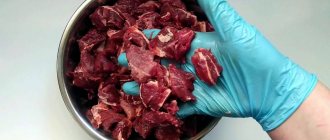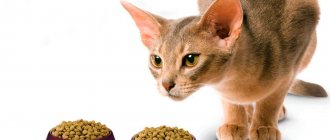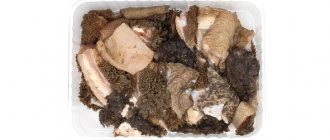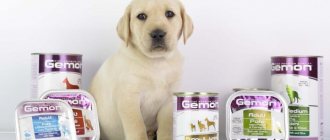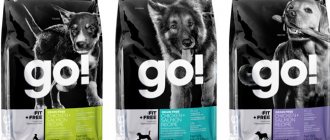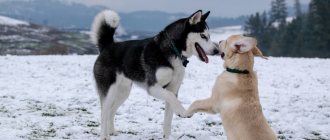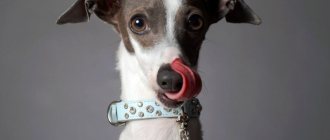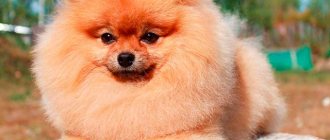The menu of dogs on a natural diet should consist of a set of substances necessary for the body. Many owners, caring about the health of their pets, are constantly looking for products that can diversify and supplement their diet.
By-products are a source of many useful microelements and vitamins, but not all of them are equally useful. Let's find out whether it is possible to give dogs cow's udder and whether it is beneficial for them.
What are the benefits of cow by-product?
A cow's udder is a by-product of the first category. Its benefits can be assessed by its chemical composition. It is rich:
- proteins;
- minerals - more potassium than in other offal;
- vitamins E, H, PP, group B;
- Collagen – essential for maintaining coat quality and skin health.
Thanks to its composition, it is able to support all body processes, accelerates adaptation to heavy loads, and allows you to build muscle mass in a short period of time. Recommended for adding to the menu during preparation for an exhibition or pregnancy.
Is there any harm?
The udder consists of connective tissue with a large amount of fat, which requires strict control in the animal's diet. If it is consumed excessively, negative symptoms may appear that indicate problems with the pet’s health:
- disruption of the gastrointestinal tract;
- obesity;
- liver dysfunction and diseases;
- problems with the pancreas.
It is also important to distinguish the milk (working) udder from the dry udder (from a calving or old non-milking cow). Milk udders are not as fatty as dry udders, but are not suitable for dogs with milk protein intolerance.
At the same time, the dry udder has a high fat content and is dangerous for individuals with liver diseases or a sensitive digestive system.
How to give?
The udder is not suitable for use as the main diet. Its high fat content makes it difficult for the body, and not everyone can digest it. It can be given in limited quantities a couple of times a week, as a treat or as a reward for training. Can be added to porridge or vegetables.
Be sure to start introducing food with a small piece, monitoring your condition over the next 24 hours. If there are signs of indigestion or allergies, it is necessary to exclude it completely from the diet. If well tolerated, you can gradually increase the amount.
What by-products can be given to a dog: allowed products and how to prepare them
Using tripe will not only diversify the menu, but also enrich the body with essential substances. They use different parts of the carcass, boiling them or offering them raw.
Avian
Bird carcass parts are a cheap and nutritious food. They contain a lot of collagen and protein. However, poultry offal rarely provokes allergic reactions.
Hearts, liver and stomachs
Chicken or duck liver contains vitamins A and B12. Heart tissue and ventricles of birds are an excellent source of protein. They include zinc, iron, collagen. They should be offered to four-legged animals only in boiled form, no more than 2 times a week.
Too much vitamin A worsens bone health and reduces muscle mass. Heat-treated liver is added to porridge or used to make soup.
Necks, heads and paws
These parts are a favorite treat for your pet. In addition, the necks, heads and paws saturate the pet with calcium, phosphorus, collagen and elastin.
Broth or jellied meat is prepared from chicken feet to feed puppies. The necks and heads make healthy soups and porridges. They do not have hard bones and are easy to digest.
However, it is important to remove their beaks and claws before feeding them. It is permissible to use poultry entrails without prior heat treatment.
Beef
Beef by-products are often used in dog menus. All parts of a cow carcass have a positive effect on the four-legged body, because they are a storehouse of vitamins and important elements. Beef udder, kidneys, heart and other innards are suitable for dogs.
Heart
The heart has a denser structure than meat due to the large amount of protein. It contains selenium, zinc, phosphorus, important amino acids, elastin and collagen. It is useful to use it raw, since heat treatment destroys a large proportion of the elements.
Scar
The rumen is a part of the cow's stomach that contains a lot of protein, enzymes, special bacteria and amino acids. These substances promote better digestion of food, neutralizing toxins and strengthening the dog’s immunity. Green tripe is considered the most useful.
Before treating your pet to a delicacy, the tripe is thoroughly washed. It is acceptable to eat raw and cooked organ. To remove the unpleasant odor, the tripe is frozen for two days.
Language
This is an expensive product, so it is rarely added to animal diets. The tongue is used both raw and processed. The chemical composition is similar to the spleen. Suitable for training the jaw muscles.
Spleen
An organ containing large amounts of protein, iron and amino acids. Before use, the spleen is boiled and given no more than once a week. An overabundance of the spleen causes diarrhea.
Udder
Beef udder contains a high percentage of fat, so it should not be used frequently in the menu. Abuse provokes digestive system disorders and allergic reactions.
In small quantities, the udder is useful during increased activity for building muscle tissue. It is boiled or served raw, after removing excess fat and cutting into small pieces. Veterinarians give recommendations on how long to cook beef udder for dogs: the cooking time takes 2-3 hours and depends on the age of the animal that will eat this product.
Beef brains
The brain contains many substances such as lipids and choline, which are useful to saturate the four-legged body with before the planned mating. In addition, brains are a nutritious product that can quickly satiate a pet. The brains are boiled before adding to the porridge.
Tails and cartilage
They have little protein, but an abundance of calcium and phosphorus. The tail and cartilage are a storehouse of useful amino acids and trace elements. Dogs of any age love to chew cartilage for a long time, so even puppies are allowed to eat them during the change of teeth. Veterinarians recommend the use of tails and cartilage without prior boiling.
Cheeks, nose, lips
These parts of the carcass are rich in protein and consist of highly digestible muscle tissue. Broths and jellied meat are prepared from them, suitable for feeding puppies or elderly animals. The main thing is to cut off excess fat from the surface of the raw material. The cheeks, nose and lips themselves are added to food in boiled and chopped form.
Lung
This organ is not rich in animal protein and has mainly connective tissue. Liver is poorly digested and absorbed, so it is not welcome in a dog’s diet. Eating lung can cause vomiting and intestinal upset. It is used only as an additive to the main meal in small quantities. For this purpose, the lung is boiled and cut.
Bovine testes
This is a real delicacy that four-legged animals really like. The testes contain very tender meat, suitable for feeding puppies, lactating females and weakened individuals. They are not recommended only for males who are about to mate in the near future - bull testes cause overexcitation of the male's nervous system and complicate mating.
Fresh parts of the bull are boiled for half an hour and then peeled off with a knife. After cooking the bovine testes, it is recommended to pour out the broth, and finely chop them before adding them to the porridge.
Liver and kidneys
These organs contain vitamins A, B12, which are essential sources of folic acid and strong antioxidants. The liver does not contain toxins and has a good effect on the functioning of the reproductive organs.
Use tripe no more than once a week. Thus, its volume in the diet should not exceed 5%. A large amount of liver and kidneys in the diet leads to disruption of the digestive system. Raw entrails are heat treated and cut into small pieces.
Pork
Pork liver and trimmings are quite fatty raw materials, so they must be introduced into food with caution. Excessive consumption of pork offal leads to obesity or the development of food allergies.
Heart
Pork heart is used in the diet only after fat has been removed from its surface. Consuming this organ increases your pet's stamina. The heart contains coenzyme Q10, which improves immunity and prevents aging of the body.
Selenium, zinc, phosphorus and beneficial acids help build the necessary muscle mass and maintain the required energy level. The structure of the heart resembles muscle tissue. It is allowed to introduce raw or cooked product into the dish.
Liver and kidneys
Eating them helps you get another source of vitamins A, B, folic acid and iron. All these substances stabilize the functioning of the nervous system, saturate cells with oxygen and participate in metabolism.
The liver is especially useful in the nutrition of lactating females and growing young animals. It is preferable to feed animals raw liver and kidneys. To prevent pets from becoming infected with worms, the insides are placed in the freezer for several days. Heat treatment is also possible, but it will significantly reduce the amount of useful elements.
Spleen
In terms of the presence of amino acids, the pork spleen is close to the liver and muscle meat - this organ contains a lot of protein and iron. Spleen is suitable for adults and elderly individuals.
Puppies are given a spleen only after 6 months. It should be added no more than once a week. The spleen is boiled for at least 2 hours, crushed and combined with porridge.
Ears and cartilage
This is a cheap raw material with a large number of elements, without which the proper development of bone and muscle mass is impossible. The trim trains the jaw well, cleans the teeth and massages the gums.
Before use, the ears and cartilages must be thoroughly cleaned of dirt using water or a knife and placed in the freezer for three days. Then they are treated with boiling water.
Is it possible raw?
You can give it raw, but there are big risks. The mammary gland of a cow accumulates medicines: antibiotics and hormonal drugs. Before slaughter, the cow could have mastitis, and by eating the udder, the dog will also receive drugs that negatively affect the body.
Therefore, a boiled product is recommended. But you need to take into account that during cooking the bulk of the beneficial substances are destroyed.
Everything you need to know about beef udder for dogs
The menu of dogs on a natural diet should consist of a set of substances necessary for the body. Many owners, caring about the health of their pets, are constantly looking for products that can diversify and supplement their diet.
By-products are a source of many useful microelements and vitamins, but not all of them are equally useful. Let's find out whether it is possible to give dogs cow's udder and whether it is beneficial for them.
How to choose?
The first thing you need to pay attention to is the quality of the product. The best option would be to find a reliable supplier of meat products who can confirm safety and quality with documents.
Usually, in large chain stores and on the market, all meat products undergo sanitary inspection before going on sale. Or take it from familiar farmers who can guarantee the health of the cow at the time of slaughter, and will tell you whether it is dairy or dry.
The dried fruit can be boiled and added to porridge or vegetables. And only milk udder can be given raw, as it is less fatty. In appearance - in the shape of a small ball of pinkish-yellow color.
You can determine the milkiness by cutting - milk will flow, or by smell - there should be a distinct smell of fresh milk. If the smell is sour, this may indicate that the product is stale. Having purchased a high-quality and fresh udder, all that remains is to remove excess fat and treat your pet with a healthy treat.
Selection and storage of offal
Dogs should not be fed spoiled offal. If the giblets have an uncharacteristic consistency, smell unpleasant and have an unhealthy color, it is better to throw them away. Some owners soak the tripe in water with the addition of baking soda, but it is better not to risk it.
Before giving raw giblets to your pet, they must undergo a veterinary inspection. If no research has been carried out, they need to be boiled or frozen. By-products obtained from sick animals can cause great harm to the health of your pet.
We recommend this article:
Healthy treats for dogs or how not to harm your pet
How to cook?
It is necessary to wash it uncut. Dry, trim off fat and freeze. It’s a little more convenient to cut the ice cream into pieces.
Recipes
Recipe No. 1.
Ingredients for a 3 liter saucepan:
- cow udder – 0.5 kg;
- rice (or any other favorite cereal) – 100 g;
- large carrots – 1 piece;
- zucchini – 0.5 pcs;
- greenery;
- vegetable oil – 1 tbsp.
Preparation:
- Boil the udder cut into medium pieces for 40-50 minutes, after which remove the pieces onto a plate.
- Cut the vegetables into small cubes (or grate them on a coarse grater).
- The udder broth is very fatty, so we leave only 1 third in the pan and dilute it with water. Cook the cereal until done.
- While the rice is cooking, you need to chop the boiled pieces, approximately the size of vegetable cubes, so that the dog does not pick them out of the porridge.
- Add chopped vegetables, herbs, butter and udder to the cooked and half-cooled cereal, mix.
Recipe No. 2.
The ingredients are the same as in the previous recipe. Zucchini can be replaced or supplemented with pumpkin, and add bell pepper or fresh cucumber. Vegetable oil can be replaced with flaxseed, rapeseed or fish oil.
Preparation:
- Boil the udder pieces and place in a separate storage container.
- Pour the broth into a jar.
- Boil rice in a separate pan
- Store the prepared ingredients in the refrigerator. Before feeding, finely chop everything, mix, season with oil and finely chopped herbs.
How long should you cook?
The cooking time should not exceed 1 hour. In order not to boil down all the beneficial substances and it does not turn into minced meat, the recommended time is 40-50 minutes.
The second basis of nutrition is rice.
When talking about what kind of cereal to give your dog, we cannot forget about this valuable product. It is the basis of dietary nutrition and is included in all ready-made premium food. Therefore, do not forget about it if your dog eats natural products.
It is no secret that nutritional properties depend on the type of rice and the method of processing the cereal. It is best to choose unpolished grains, brown or brown rice. It retains healthy fiber, while polished cereal is a source of starch. So what are the best cereals? Dogs should be fed buckwheat and rice. They can be combined with each other. You can boil the cereals separately, and then mix them with meat and broth in a cup.
If you take unpolished rice, be sure to rinse it well. It cooks for about 35 minutes, after which you need to let the porridge brew, otherwise mucus will appear in it. If your dog is picky and does not eat porridge well, then it is better to cook the rice in salted water. Proper dog porridge can also be prepared from polished cereals. In this case, a spoonful of olive oil is added to it during cooking. This way it turns out more tasty and does not stick together.
Dried
Dried products, although much more expensive, have a number of advantages:
- Thanks to certain cooking conditions, all the beneficial properties and natural aroma are preserved (unlike boiled, where some of the beneficial properties are simply destroyed during the cooking process).
- It is convenient to store and transport, you can take it on the road and not worry about maintaining the temperature regime.
- Convenient to use for training.
- This is a natural chew that your dog can use to clean their teeth.
- Strengthening the jaw apparatus.
- It can be added to the diet even for individuals who eat ready-made food.
The most famous and relatively inexpensive brand of dried meat products is TiTBiT. Reviews about this manufacturer are mixed: some praise and note that dogs happily chew treats without any consequences, but there are many negative reviews that note allergic reactions and serious consequences that require treatment.
Lesser known brands:
- Tortdogs;
- Lucky Dog;
- Nordic Deer;
- DogRog.
DogRog is not one of the cheapest in terms of cost, but both the manufacturer and its products have received many flattering reviews: consultations on individual selection of treats, fast delivery to all cities of Russia, no complaints about quality.
Making at home
Drying at home is a rather complex process that does not guarantee long-term storage of the product. But many owners dry offal themselves:
- wash and dry with a paper towel;
- put in the freezer for a short time;
- after it has frozen a little, cut into small pieces and place on a baking sheet lined with baking paper;
- preheat the oven to 80 ⁰C, place a baking sheet there for 2-3 hours, depending on the size of the pieces;
- Store dried chips in the refrigerator.
Different breeds
It is not recommended to feed to representatives of breeds with characteristically sensitive digestion.
The nutritional qualities of the udder and high fat content are necessary in feeding service and sports breeds, as well as captive breeds, especially in the autumn-winter period. Under additional loads and in low temperature conditions, fatty foods in reasonable quantities do not pose a danger, and are even very useful.
It is also recommended for representatives of breeds with a high risk of allergies: Chow Chow, French Bulldog, Akita Inu, Great Dane, Shar Pei, etc.
At what age should it be given?
But here it is important not only to know how long the udder takes to cook, but also when you can give this treat to dogs. The optimal age is from three months. But at this time the udder should not be dry, otherwise the puppy will break its teeth. Of course, you need to monitor the body’s reaction very carefully and, if there are alarming symptoms, exclude the product from the diet.
For puppies
Puppies should be given treats little by little. On the one hand, it helps them grow quickly and very strong, but on the other hand, if they are overfed, serious problems with obesity can begin.
Pregnant and lactating
Pregnant bitches should be given udder in very small quantities. Otherwise, excess calories combined with low mobility will cause the dog to gain excess weight. It can also cause serious difficulties during childbirth. Therefore you need to be very careful.
But nursing mothers can be given a larger udder. This will help the bitch get into shape faster and recover after giving birth.
No one can resist the deliciousness
Different breeds
Some dogs tend to have a sedentary lifestyle and, as a result, low calorie expenditure. First of all, these are mastiffs, English bulldogs, Pekingese, and pugs. It is better not to give them an udder, otherwise problems with excess weight may begin. If the dog runs a lot and with pleasure, then the extra calories will evaporate before our eyes and no harm will be done to health.
Remember! Dogs that often have allergies (Shar Pei, Great Dane, Akita Inu, French Bulldog, Chow Chow) should be given udders with particular caution.
